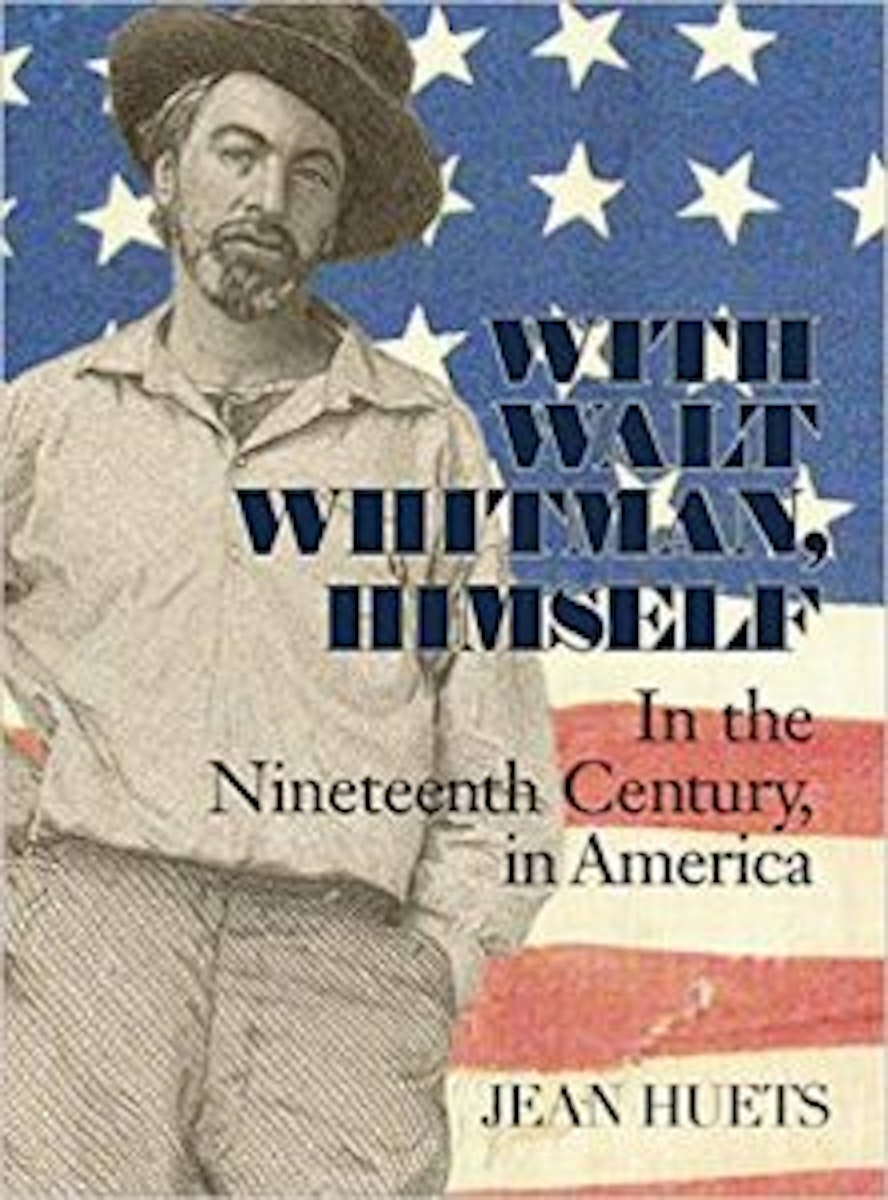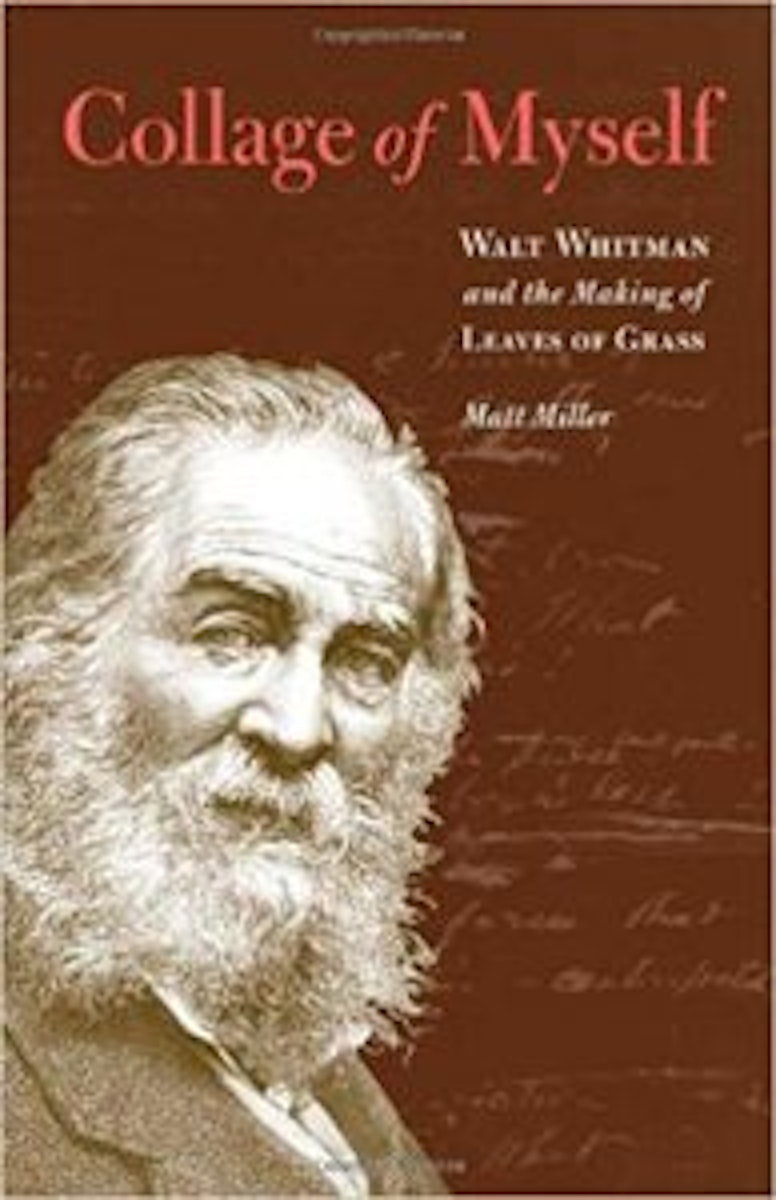
Walt Whitman in Russia Three Love Affairs
Walt Whitman’s influence on the creative output of 20th-century Russia — particularly in the years surrounding the 1917 Revolution — was enormous. For the 200th anniversary of Whitman's birth, Nina Murray looks at the translators through which Russians experienced his work, not only in a literary sense — through the efforts of Konstantin Balmont and Kornei Chukovsky — but also artistic, in the avant-garde printmaking of Vera Ermolaeva.
May 29, 2019
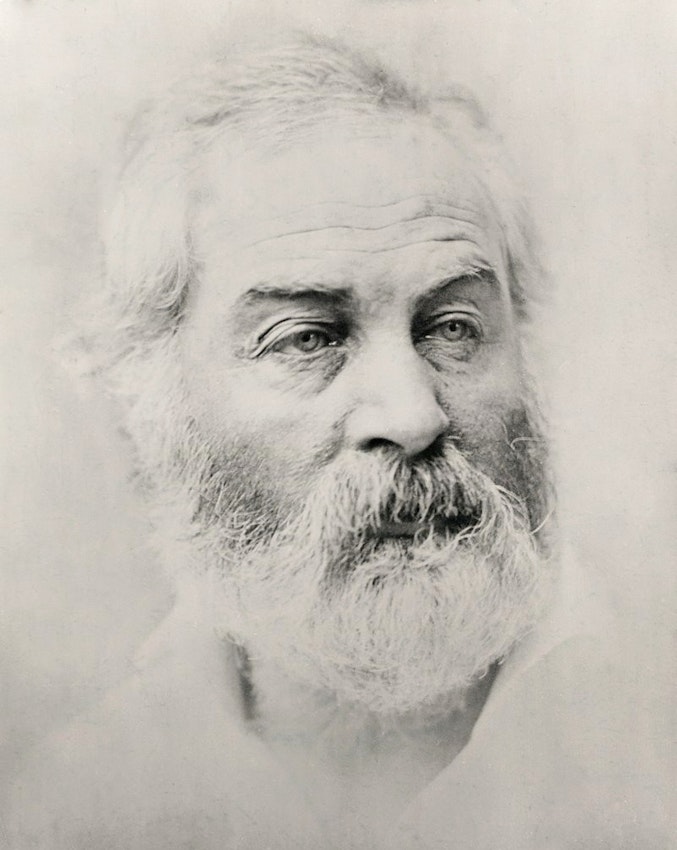 Scroll through the whole page to download all images before printing.
Scroll through the whole page to download all images before printing.Walt Whitman by Alexander Gardner, 1863. Whitman referred to the photograph as his “best picture of all” — Source.
At the core of any translation venture, at the nucleus that shapes all its qualities, lies an often random and routine event — an individual’s encounter with a text. Before a translator dons the mantle of a cultural ambassador, a conduit of knowledge, a missionary of art, or whatever other responsibility inevitably comes with taking a work of literature from one language to the other — before the translator steps into the very public space of cultural advocacy — he or she is merely a reader seduced by an imagined world.
If it weren’t for a handful of change in sixteen-year-old Kornei Chukovsky’s pocket one day in Odessa, Whitman’s “Song of Myself” may not have come to shatter and shape the Russian poetic imagination until a generation later. Chukovsky was a school student, teaching himself English from dictionaries, old newspapers, and whatever he could buy from sailors. What were the chances that on that particular day, for that particular school-kid, the sailor would bring Leaves of Grass? But that’s how it happens — somebody, somewhere, flips a book open, and it speaks to him, changes his way of seeing the world, and alters his soul.
Other great Russians had read Leaves of Grass. Tolstoy got a copy from one of his fans in England in June of 1889, read it, and wrote in his diary, “These are awkward verses”.1 He was surprised to learn from his friends abroad that in Europe his own work was often compared to Whitman’s and conceded to give the book a second chance. In October of the same year, Tolstoy noted, “There is much that is blown-up, empty, but I did find some good things this time.”2 Turgenev, while living in Paris in the 1880s, read Leaves of Grass too and penned down a draft translation of “Beat! Beat! Drums!” but that single sheet remained the full extent of his interest in Whitman.
Whitman needed not a mere celebrity endorsement, not just an appreciative aesthete, but a lover in Russia: a passionate, devoted reader who would accept him without judgment. Before Chukovsky could have the luxury of spending years on his eleven editions of Whitman’s poetry, somebody else had to discover Whitman. Chukovsky’s energetic verse would carry Whitman to the masses, but it would be feeding the hunger inspired by another translator who had given Whitman a divine aura in the Russian imagination. That person was Konstantin Balmont, bohemia incarnate, Symbolist luminary, globetrotter, poet.
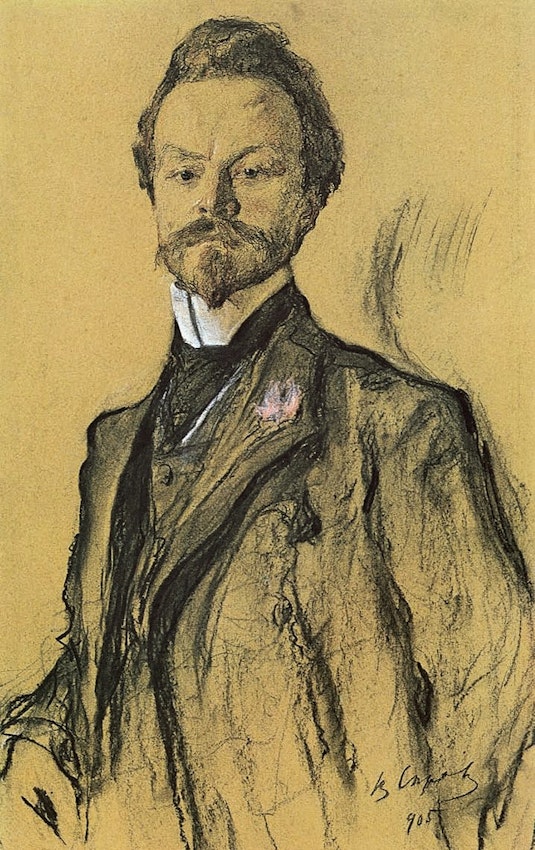 Scroll through the whole page to download all images before printing.
Scroll through the whole page to download all images before printing.Portrait of Konstantin Balmont by Valentin Serov, 1905 — Source.
When in the early 1900s Konstantin Balmont (1867–1942) set himself the task of bringing the work of Walt Whitman to a Russian audience, he did so with a very definite set of opinions on how and why this task ought to be pursued. “True poets”, he wrote about Whitman in 1920,
are always seers and prophets. They feel for many people, blend their souls with all creatures, make their minds present in the past, present, and future. If they are sensitive at all, the great epochs of change and reformation especially attract their imagination and having charmed them magnetically, such times send omens into the poets’ work, throw upon their writing flashes of their coming fires, the first blazes of their pearly and scarlet, tender, and ferocious dawn.3
Balmont introduced Whitman to the readers of the Symbolist journal Vesy as “a powerful dweller on earth . . a chaotic, young, unbridled and undisciplined soul”.4 In subsequent essays, Balmont developed a language of such reverence and grandeur as were rarely bestowed on poets even within Russia’s then indulgent artistic milieu: Whitman was an “ultimate”, an “inevitable”, “strong” poet, “as inescapable in the life of our souls as the first love, first grief, a moonlit night, or a sunny morning.”5 His poetry, then, could not be akin to anything before or contemporary to it. Writing in 1908, Balmont denied Whitman’s verse any “accessible consonance of rhyme”, “common ornamentation of poetry”, or any “correct measure”, seeing in it, instead, the “movement of waves”, “rustling of breezes”, and the “breath of the sea”.6 As if determined to make his words a self-fulfilling prophecy, Balmont enslaved himself to the original text, like a desperate lover. He crafted translations that were so accurate in their mimicry of Whitman’s sentence and line structure that they were faithful to a fault (the clumsiest examples include “The Bravest Soldiers” turned into bravye [dashing] soldiers and the “common prostitute” becoming obshchaya [shared], the first meaning of “common” in Russian). As desperate lovers are wont to do, Balmont also projected his own glorified vision of Whitman as an icon of a new world onto Whitman’s work. As Martin Bidney noted in his excellent essay “Leviathan, Yggdrasil, Earth Titan, Eagle: Balmont’s Reimagining of Walt Whitman”,
In presenting the American sage to the Russian public Balmont shaped both the Whitman persona and the form of its utterances according to his own style of writing, his own mode of vision, both in verse and prose. . . . Balmont’s reinterpretation of Whitman in his translations and criticism involved a full-scale reimagining of Whitman and his work in visionary terms, the terms of poetic myth.7
For Whitman to sound like a prophet, however, his had to be the language of revelation: biblically self-referential, intentionally vague yet containing enough clues to suggest a hidden grand scheme. Thus, Balmont felt compelled to infuse the language of his translations with coded significance, over-using repetition, narrowing synonymic rows to one or two “key” words — as if beyond Whitman’s catalogues there lay another reality, to be summoned by rites and incantations, by repeating lines until meaning peeled away and only the ritual remained. This Symbolist treatment was supported by Balmont’s main venue at the time — the influential literary almanac Vesy, which in 1909 proclaimed itself a magazine to support art’s “unbreakable connection to the spheres of mysticism, metaphysics, and religion.”8
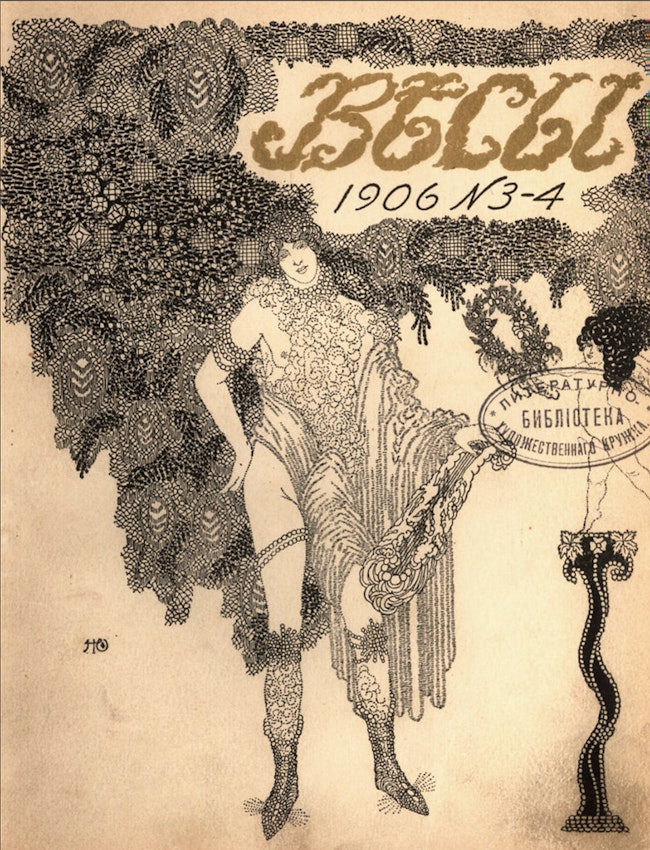 Scroll through the whole page to download all images before printing.
Scroll through the whole page to download all images before printing.Front cover to a 1906 issue of Vesy — Source.
Balmont’s position as an important Symbolist poet and translator had long been secure. His apologia for Whitman as a cosmic, universal prophet of a new order could not have reached a more grateful audience than that of Russian students and intellectuals who were being wooed by the ideas of a universal, sweeping revolution that would propel their country into the front ranks of the new century’s democracies. Not only would such revolution do away with Russia’s backward economic systems, but it would also create a new social mentality, a new way of being a Russian. With his translations of “The Song of the Broad-Axe”, “Salut au monde”, “O Star of France”, and “Beginners”, Balmont enabled his readers to conceive, with the blessing of Whitman’s vaguely embodied sense of phallic privilege, of how this new way of being in the world could be built, carpenter-like, with hand-held tools. In Balmont’s vision of Whitman’s world, anyone with a pair of strong hands and a tightly fitted pair of trousers was free to work, celebrate, grieve, and lust without the sanction of a higher authority. To the young and the romantic, that sure beat marble-hall theorzations under some wise academician’s ironic scrutiny.
To say, however, that the success of Whitman’s poems depended entirely on their appropriation by the purveyors of liberal propaganda is to ignore the poetry’s deeply spiritual resonance, without which the mysterious Russian soul simply would not be itself. Ilya Repin, a painter and a Christian philosopher, expressed this resonance well when he wrote:
It was an unexpected surprise for me to discover the meaning of this holy fool (yurodivyi) American, who rose suddenly in front of me as Christianity’s second sun. God’s child, Walt Whitman revealed in his simple heart anew the true meaning of God’s Word. Of course, I am unable to express the full importance of this raving apostle of the new democratic religion, but I believe this religion of fraternity, unity, and equality is not as new as it appears to Mr. Chukovsky [Whitman’s canonical Russian translator]: it had been announced to the world almost twenty centuries ago.9
This view of Whitman as the divinely inspired barefoot blabber sustained by charity, Christ-like in his innocence and indiscriminately kind, had to capture many an imagination brought up in the Russian Orthodox tradition. Liudmila Kiseliova provides excellent insight into this cultural environment in her essay “Poetic Dialogues of the Silver Age: K. D. Balmont and N. A. Klyuev”. In Russia at the time, Kiseliova writes, writers and philosophers
attempted to overcome the consequences of secularization, to return to the all-sacred word of the ancient Russian religiosity of knowledge. The concept of Word as Logos implied an intimate connection between man and the Divine truth through language.10
Return to such concepts of language brought about great interest in the folklore and the Old Believers, whose doctrine never abandoned linguistic mysticism and the zapovednoye (bequeathed) knowledge of the Divine contained in verbal expression.
To the more secular crowd, from which Kornei Chukovsky would come, this construction of Whitman’s love as Christ-like caring provided a convenient excuse for dealing with the poet’s sexuality: it was agape — not eros — that drove Whitman’s speaker to rhapsodize
O TAN-FACED prairie-boy, . . . You came, taciturn, with nothing to give—we but look’d on each other, When lo! more than all the gifts of the world you gave me.
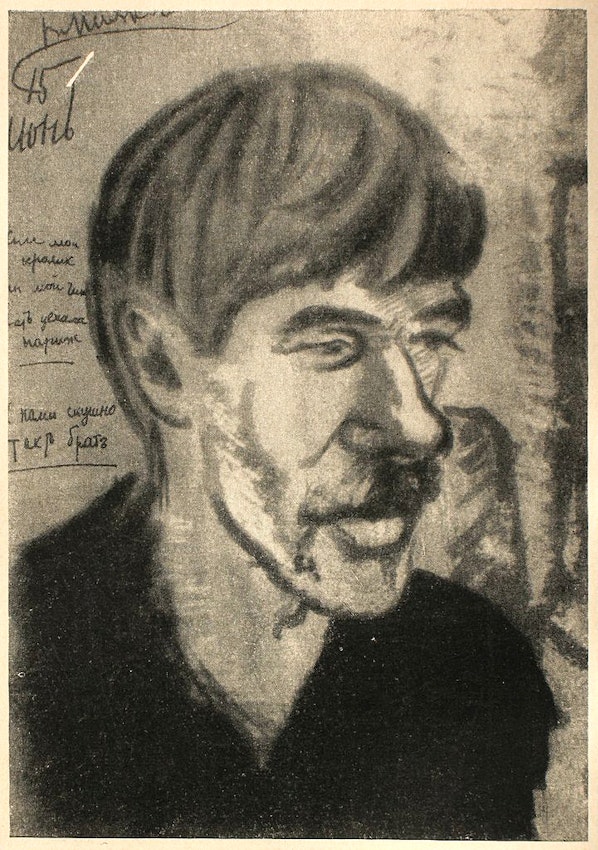 Scroll through the whole page to download all images before printing.
Scroll through the whole page to download all images before printing.Drawing by Vladimir Mayakovsky of Kornei Chukovsky, 1915 — Source.
Kornei Chukovsky (1882–1969) was the kind of translator who would ask his friends and colleagues to destroy his first rendering of Whitman’s poetry as unworthy and shameful to both Whitman and himself. Apparently the friends agreed, because the only surviving clue to this early translation is Chukovsky’s confession in the preface to the 1913 collection of translations from Whitman: “I published about Whitman a pamphlet about ten years ago and I am not at all pleased with it.”11 This 1913 edition did not survive either: the book’s entire run was censored and confiscated. Thus, we must take 1919 as the year of Chukovsky’s first book-length treatment of Whitman, the first in a series of ten more volumes published until 1969. Chukovsky’s own poetic sensibilities can best be characterized as avant-gardist; this is considered by biographers one of the reasons for which Chukovsky’s talent as a poet was conscribed to children’s verse in the Soviet era. Unlike Balmont, who had an intuitive — and brilliant — affinity for complexly metered, if not necessarily rhymed, verse, Chukovsky’s ear was more rhythmically tuned. Where Balmont highlighted and regularized Whitman’s dactyls, Chukovsky would pursue a more direct sonic reflection of content, often at the expense of strict verbal precision. It was precisely this choice, however, that enabled Chukovsky’s translations to reflect the diversity of Whitman’s expression and made his translations canonical. And yet Whitman was slipping through a translator’s fingers again.
Anyone attempting to translate Whitman into Russian must be prepared to resolve a number of issues on a regular basis. There is Whitman’s superficial plainness which can lull a translator into relying on close lexical equivalence alone. But then these words that slip and saunter easily into the reader’s mind turn out to be uncommon, culled from such a variety of dictions, registers, epochs, and contexts that stringing them into sentences becomes a titanic burden. On top of this, Russian grammar requires that pronouns, nouns, adjectives, and some verbs be gendered. The choice of gender demonstrates most clearly a translator’s ideological and/or moralistic concerns — and it is most central in “Children of Adam”.
In Whitman’s own language, the powerful “I” never ceases its hold on the gravitational center, the source of the gaze, the nucleus from which the speaker reaches out to consider the subject, be it the generic “women” or the intimate “you”. Pulled into this undiscriminating orbit, all things become depersonalized; they are first and foremost the objects of longing or desire, and their gender identification is often secondary. The Anglophone reader, if so inclined, is at liberty to assign hetero- or homo- vector to the sexuality expressed in “Children of Adam”, and specifically to the arc of desire narrated in "One Hour to Madness and Joy”.
Both Balmont and Kornei Chukovsky perceived this ambiguity and articulated its importance to Whitman’s world-view in their critical essays. For example, Balmont wrote in his foreword to Leaves of Grass (Pobiegi travy):
Through the continuous symbolization of everything that appears in the flowing course of life even for an instant, through the confluence of all individual streams into one cosmic Ocean, Whitman approaches the triumphant assertion of the I over and over again. This I has looked into the mirror, and walked away from its own image towards the Asserted Being — the state in which it constantly spends itself without losing a single drop, and if perhaps it loses some, it doesn’t regret the expense. 12
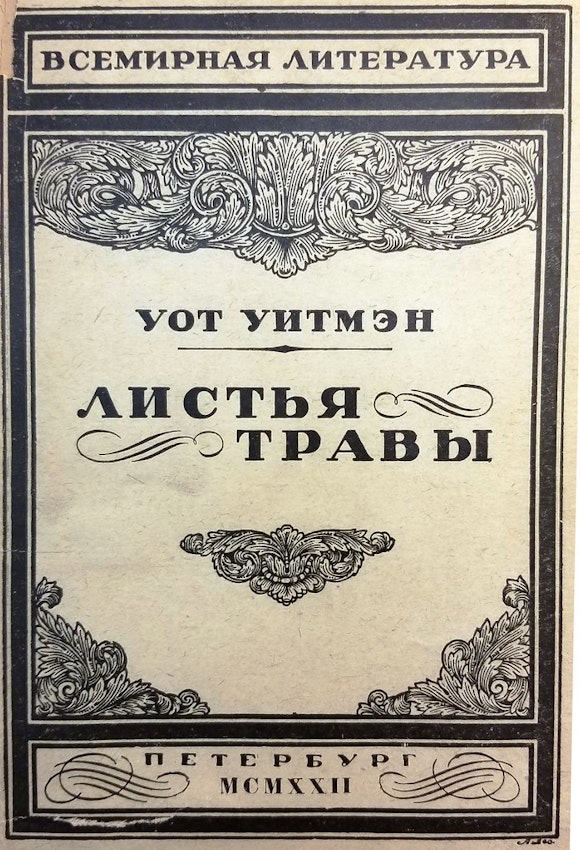 Scroll through the whole page to download all images before printing.
Scroll through the whole page to download all images before printing.Front cover to Chukovsky’s 1922 translation of Leaves of Grass (Listʹia travy) — Source.
When one keeps in mind Whitman’s fixation on liquids, especially those of the impregnating variety, Balmont’s choice metaphor cannot be considered pure whimsy. Chukovsky also interprets the undiscriminating desire of “Children of Adam” as a religious, other-worldly, beyond-the-self experience. For Chukovsky, it is precisely this omnivorousness, this lust for earth, weather, emotion, for men and women that enables Whitman to advance to a new form of romance, one that will replace the medieval cult of the Fair Lady with “the cult of the Comrade, the cult of the democratic friendship, because people’s hearts fill more and more with this new tenderness, the fondness for the colleague, co-worker, fellow traveler, for the one who walks in step, shoulder to shoulder with us, who is a part of our common march”.13
But no amount of interpretation alleviates the challenge of choosing a gender for the object of the speaker’s desire in “Children of Adam”. “One Hour to Madness and Joy” must indeed have seemed maddening — no clear assignment in the title, no clarifying reference to the “work of fathering”, just the urge to be intimate with someone, despite the obstacles put forth by the social order.
Whitman provides but one line of apparently sure footing: “O to return to Paradise! O bashful and feminine!” Both translators rendered “bashful” and “feminine” in feminine gender, i.e. as explicitly describing a woman. However, even a contemporary reader could have chosen to see these qualities applied to a man; Whitman’s adjectives, after all, never suffered from orthodox connotations. To add to the difficulty, this seemingly clear line comes after: “O to be yielded to you whoever you are, and you to be yielded to me in defiance of the world!”14 This line presented a problem for Balmont with its non-committal “whoever you are”. In Russian, unfortunately, this phrase can hardly be rendered without a gendered verb, and Balmont chose the masculine ending. In the second part of the line, the choice of the feminine gender seemed just as natural, so that (in back-translation) the result is “O to give myself to you no matter what man you are, and to take you, the woman who gives herself despite the whole world!”15 Chukovsky is more thorough and eliminates any hint of ambiguity: “O to give myself to you no matter who you are, woman, and for you to give yourself to me / Despite the whole cosmos!”16
Whitman’s following stanza strongly suggests the forbidden nature of this desire:
O to speed where there is space enough and air enough at last? To be absolv’d from previous ties and conventions, I from mine and you from yours! . . . To have the gag remov’d from one’s mouth! To have the feeling to-day or any day I am sufficient as I am.17
The last two lines especially invite a homoerotic reading. The speaker’s desire is not only unconventional but also unspeakable (the “gag”) and perhaps, according to one reading, even unwelcome. In the pursuit of cosmic exultation that he saw Whitman proclaiming, Balmont, who declared his translations to be as literal as his “aesthetic feeling” would allow, magnifies the speaker’s doubts into a whole history of self-loathing:
O, to escape to where there is finally enough space, enough air! To be free of old chains and conventions, I of mine, and you of yours! . . . To feel one’s mouth unlocked, the mouth that had been sealed! To feel clearly that now, and whenever I am happy with myself, I am happy!18
Instead of someone who wonders, perhaps, whether an amorous liaison is exactly the complication he needs in his life, here is a speaker plagued by self-doubt and whose doubt can only be assuaged by an act of prohibited love. Chukovsky’s version, on the other hand, offers a comfortably conventional romantic predicament:
O, to break free from the old chains and conventions — you from yours, and I of mine! To take off, finally, the padlock that was on my lips, To feel that finally, today I am completely content, and I do not want anything else.19
In this version, it is the speaker himself who has the power to remove the “lock” on his lips — this implies that his previous silence has also been at least partially a choice, a gesture of conformity. Compare this to the drama of the original — “to have the gag removed”, an image of being liberated, not being held hostage any longer — and to Balmont’s sensitivity to this issue of agency and will.
Once translated, literary works enter a new life, enmeshed in the new culture, its rhizomatic reach of echoes and imitations. Both Balmont and Chukovsky wrote extensively about Whitman in an effort to relate his poetry to the status awarded to him in the Anglophone world, notoriety included. Both translators performed the work of iconization: Balmont was deeply devoted to the vision of Whitman as an exalted prophet, and Chukovsky promoted him in a familial, somewhat bemused manner, akin to the one usually reserved for a gifted but definitely weird brother. Despite their rigor, both Balmont’s cosmic myth, in which the speaker, like some primal deity, is omnisexual and omni-fertile, and Chukovsky’s Whitman as an accessible, bare-chested “bro” who lusts for human contact and kindness are re-readings, hybrids of the Whitman genus. What is important to remember is that the Russian reading public, through the efforts of both translators, saw Whitman as the prophet of a new order — a phenomenologically different world in which emotions, identities, and the most basic desires are transformed by the power of a democratic egalitarian society. Young people in the 1920s banded into Whitman fan clubs — groups dedicated to discussing Whitman and his ideas. Chukovsky visited one such gathering in 1922 and wrote in his diary:
Whitman appeals to them as a prophet and a teacher. They wish to kiss, and work, and die — all according to Whitman . . . No, Russia is intact yet! I thought to myself when I left. It is strong because at its core it is so naïve, young, so “religious.” No irony, no skepticism, no humor — it takes everything seriously. They sat there — ground down with lack of bread, health, money — those young girls and teenage students and they thirsted — not for money, or firewood, or aesthetic pleasure — but for faith.
Whitman gave faith. And once this quality of his words was revealed, Russian artists felt the poetry deserved a grander stage than pages of a book. In 1918, a choral drama based on “Song of Myself” made its debut in theater. It was directed by Alexander Mgebrov and titled “An Evening of Walt Whitman”. The play traveled to great success; Mgebrov’s simple dramatization of titanic struggle in “Europe”, urban alienation in “The City Dead-House”, and the poet as the mouthpiece of a multi-faced mass in “Song of Myself” resonated with the audiences, whose members felt themselves to be forging a new future. This reception of Whitman found another dramatic and accessible expression at the intersection with another art — linoleum-cut printing.
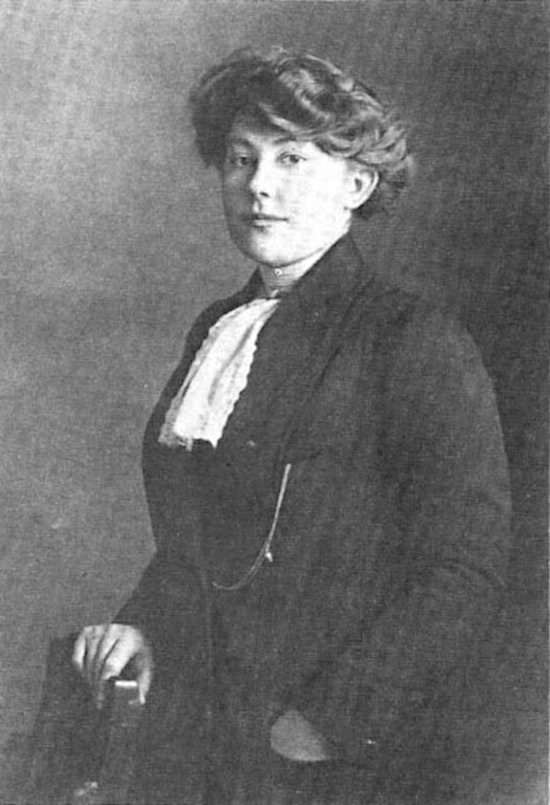 Scroll through the whole page to download all images before printing.
Scroll through the whole page to download all images before printing.Photograph of Vera Ermolaeva from the 1920s — Source.
Russia’s revolutionary ideology of equality, brotherhood, communal labor, and personal liberation would not have been possible without the easy accessibility of technology in the new industrialized era, and young artists at the time were as excited about Whitman’s ideas of camaraderie as they were about the staccato of telegraphed news reports or the quickness of linoleum-cut printing. In contrast to wood-cut printing, this technique is cheaper and less physically demanding: instead of carving a stamp of a page out of a block of wood, the artist works with pliable, easy-to-cut linoleum.
In 1918, one such artist was the twenty-five-year-old Vera Ermolaeva (1893–1937). Her group was called “Today”, and its goal — much like that of many chapbook presses today — was to produce short poetry and children’s books cheaply so they could be distributed in the trenches, hospitals, schools, orphanages, and in the streets. The co-op in which Ermolaeva worked did not see its goal of taking literature to the masses as being at odds with the aesthetic pursuit of synergy between the word and the picture; rather, Ermolaeva and her colleagues saw in their process an opportunity to improvise. They printed 100–150 copies at a time and often hand-colored illustrations after the pages were printed, so that the artist had the freedom to try out a number of color schemes and effects. Currently, copies of “Today” editions of works by Sergey Yesenin, Yevgeny Zamyatin, Yuri Annenkov, Natan Al’tman, and Whitman (illustrated by Ermolaeva) are found at international antique book auctions and in MOMA collections. The name of the translator of Ermolaeva’s edition of “Pioneers” is, unfortunately, unknown, as they are identified only by initials.
Ermolaeva’s work on Whitman’s “Pioneers” is characteristically bold, sharp, and dynamic. On the cover, two men embrace. Lightning-like lines surround them, suggesting wind, flight, or even the movement of the Earth’s tectonic plates that seem to echo the pioneers’ energy. Inside, four pages are framed with narrow bands of illustration, which, like ancient Greek friezes, summon a vision of procession, and again, movement. In these bands of action, Ermolaeva masterfully uses blocks of black to suggest dusk, night, or dawn. Figures are grouped around campfires, and women walk alongside men. In a piercing interpretive act, however, Ermolaeva puts guns into her pioneers’ hands — not hunting rifles but slim firearms with bayonets attached. On Russian soil, Whitman’s pioneers are not just breaking new ground; they are fighting for a new society. There is no violence, just a few figures resting, leaning on their rifles, but the dark backdrop is enough to suggest watchfulness, men who cannot let down their guard.
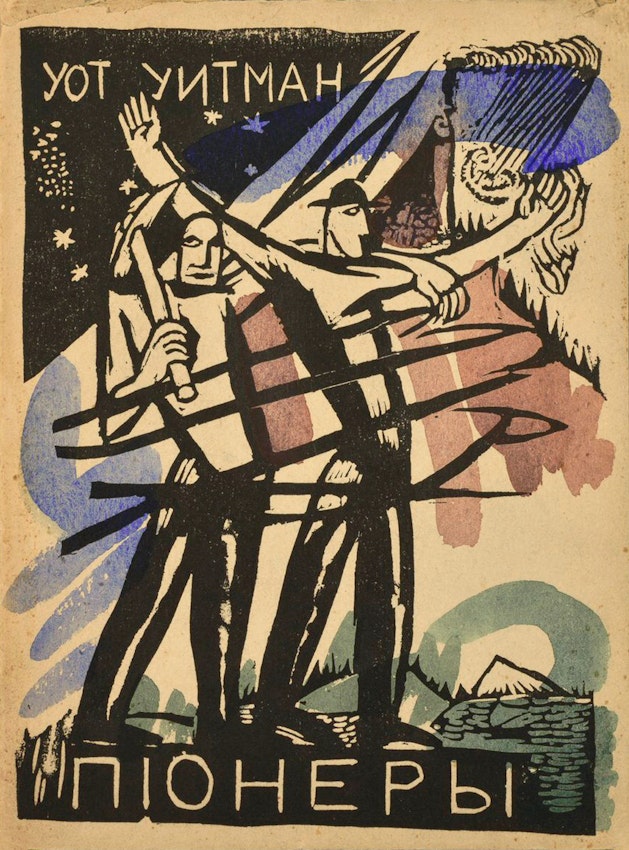 Scroll through the whole page to download all images before printing.
Scroll through the whole page to download all images before printing.Cover to Pionery (1918), linoleum cut with added watercolour, by Vera Ermolaeva — Source.
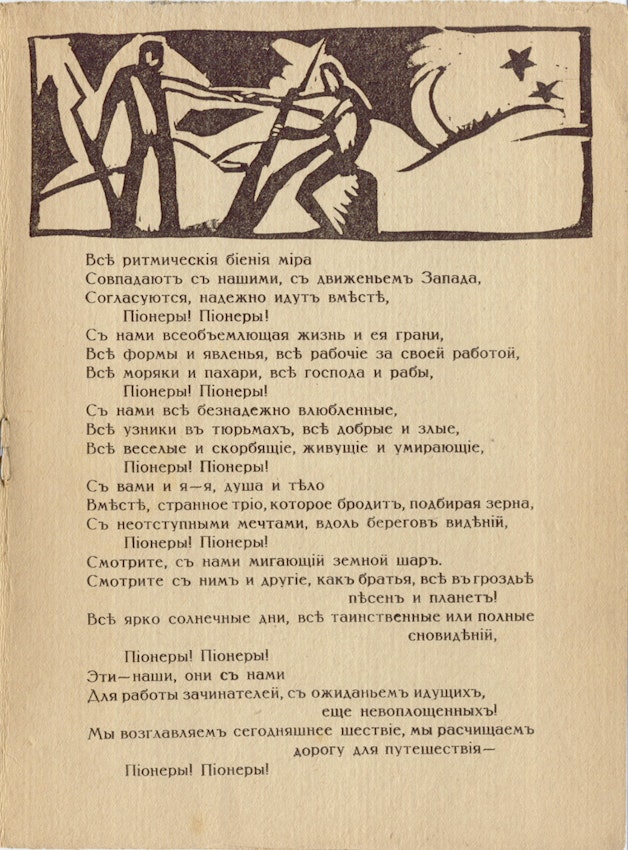 Scroll through the whole page to download all images before printing.
Scroll through the whole page to download all images before printing.Inner page from Pionery (1918) featuring a linoleum cut by Vera Ermolaeva — Source.
Ermolaeva’s vision for an eight-page chapbook has the power to crystallize for us the resonance of Whitman’s work in revolutionary Russian imagination. Reciprocally, Whitman’s poem, like the chime of a tuning fork, resonated in bold and sharp-elbowed prints from an artist who would become one of the most influential creators of children’s books.
Ermolaeva’s work in “Today” is but a small episode in a life of accomplishment, cut short by tragedy. At twenty-eight, she took Marc Chagall’s position as the Rector of the Vitebsk Applied Arts Institute and recruited Kazimir Malevich to the faculty there. Later on, she would become involved in theoretical studies of color and artistic form. During the Stalinist purges, her futuristic work contributed to the charge of anti-Soviet activities and efforts to organize anti-Soviet intelligentsia, and in 1937, Vera Ermolaeva was sentenced to death by a firing squad and executed.
The act of reading about this remarkable life, first in search of a connection to the topic of Whitman in Russia, and then for the pleasure of being captivated and inspired by it, becomes the origin of another act. The re-vision of Vera Ermolaeva’s life, with its rearranged emphases that put the inconsequential little chapbook in the limelight, brings out the supreme irony of her fate: the guns she put into the pioneers’ hands were turned upon her and fired.
Chukovsky’s translations of Whitman are still re-read and studied in Russia today. However, they now come to their readers trapped, like insects in amber, in the spirit of the time when they were made, dusted on top with the postmodern, post-Soviet backlash against that spirit. In other words, Whitman in Russian is a Russian Whitman, one whose work has yet to extricate itself from the ideology that it was once thought to purvey and to prove that its value was not merely manufactured by the hegemonic proletariat. A re-reading (and a Russian retranslation) will be an act of a new peace — with Whitman, and with Russia itself.
Nina Murray is author of poetry collections Alcestis in the Underworld, Minor Heresies, and Damascus Electric. Her translations from Russian and Ukrainian include Peter Aleshkovsky’s Stargorod, and Oksana Zabuzhko’s award-winning The Museum of Abandoned Secrets. She grew up in Lviv, in Western Ukraine, and holds advanced degrees in linguistics and creative writing.





